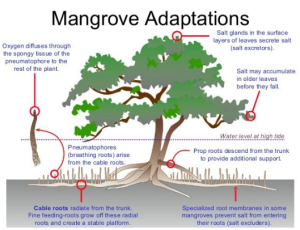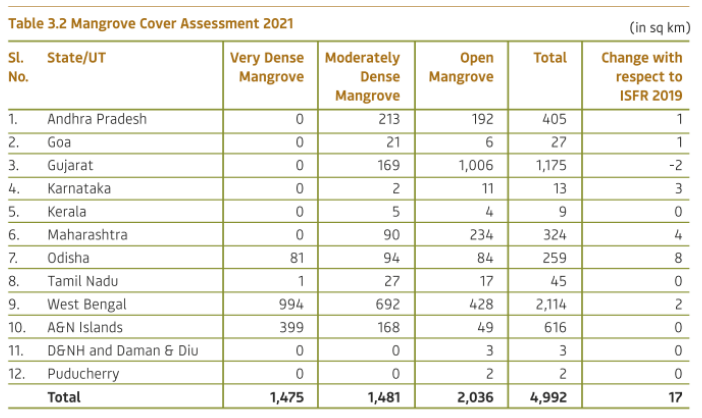Context:
Recently, International Day for the Conservation of the Mangrove Ecosystem was observed on July 26.
More on the News:
- About Day: International Day was adopted by the General Conference of the UN Educational, Scientific and Cultural Organization (UNESCO) in 2015.
- Aim: To raise awareness of the importance of mangrove ecosystems as “a unique, special and vulnerable ecosystem” and to promote solutions for their sustainable management, conservation and uses.
- Significance : Mangroves are located in “transitional intertidal zones.” i.e Mangrove ecosystems are at the intersection of SDGs 14 and 15 as they provide a buffer zone between life below water and life on land.
About Mangroves:
- Location: Mangroves are found in tropical and subtropical areas, i.e., between 25°N and 25°S latitude.
 Mangroves have specialized adaptation to survive in the extreme conditions of the coastal environment.
Mangroves have specialized adaptation to survive in the extreme conditions of the coastal environment. - They have the ability to survive in waterlogged and anoxic soil, and to tolerate brackish water with the adaptations.
- Stilt Roots
- Pneumatophores
- Salt Excretory Glands
- Salt Excluding Roots
- Viviparous seeds
- There are 24-29 families and around 70 species in the world.
- Global Number: In 2020, an estimated 147,359 km2 of mangrove forest globally, 51% of which occurred in the AsiaPacific, with 29% in the Americas and 20% in Africa.
- Indonesia has the largest area of mangrove forest – totalling 20% of the global total – followed by Brazil, Australia, Mexico and Nigeria, which together contain almost half of the world’s mangroves.
India and Mangroves:
- India is home to about 3 percent of the total mangrove cover in South Asia, with the Sundarbans in West Bengal and Bhitarkanika mangroves in Odisha being the richest in diversity.
- Sundarbans: It is one of the most biodiverse mangrove forests in the world.
- It is home to a wide variety of fauna, including the Bengal tiger, fishing cat, mangrove snakes, goliath heron, saltwater crocodile and water monitor lizard.
- According to the India State of Forest report, the country’s mangrove forest cover has increased by 930-sq-km since 1987.
- As per Forest Survey Report 2021, total mangrove cover in the country is 4,992 sq km.
- An increase of 17 sq Km in mangrove cover has been observed as compared to the previous assessment of 2019.
- Top three states showing mangrove cover increase are Odisha (8 sq km) followed by Maharashtra (4 sq km) and Karnataka (3 sq km).

Significance:
- Disaster Mitigation: Mangrove coverage acts as a natural barrier, reducing the impact of waves and protecting coastal areas from erosion.
- It stabilizes sedimentation and mitigates coastal flooding, thus providing a valuable defence against natural disasters.
- A recent study estimated that India’s mangrove systems provide annual flood protection benefits of over $7.8 billion.
- Ex: During Supercyclone Amphan in 2020, Sundarbans mangroves played a big role in protecting the life and livelihood of millions of people by acting as a bio-shield and protecting the embankments.
- Mangroves are an essential part of the “build back better” strategy in response to sea storms, tsunamis, and cyclones.
- Ecosystem Services: Mangrove provide critical habitats of a diverse range of plant and animal species, and marine organisms, including commercially important fish species.
- Sundarbans host the world’s largest mangrove forest and are home to endangered species like the Bengal tiger and Ganges river dolphin.
- Natural Filter: Mangrove forests improve water quality and act as natural filters by trapping sediments, pollutants and excess nutrients.
- They play a role in the well-being of coastal communities and health of marine ecosystems.
- Carbon Sequestration: Mangrove ecosystems can absorb large amounts of carbon dioxide (CO2) from the atmosphere and store it in their biomass and sediments in a process known as sequestration.
- Globally, they are estimated to sequester 22.86 metric gigatonnes of CO2, which is about half the annual CO2 emissions from fossil fuels, land-use and industry.
- This buried carbon is known as “blue carbon” because it is stored underwater in coastal ecosystems like mangrove forests, seagrass beds and salt marshes.
- Livelihood: Mangroves contribute significantly to the livelihoods of 900,000 fisher households in India.
- They support artisanal fisheries and provide food and income for the local population.
- Roughly about 60% of India’s coastal marine fish species are dependent on the mangrove ecosystem.
- Mangrove forests play a crucial role in nurturing estuaries and supporting nature-based economies.
- Tourism and recreation: Mangroves provide opportunities for eco-tourism, birding, kayaking, and other nature-based activities that can support local communities’ sustainable economic growth.
Challenges faced by Mangrove Ecosystem:
- Stress on Mangrove: Mangroves are disappearing at a global loss rate of 1–2% per year, and the loss reached 35% during the last 20 years.
- Since 1996, the planet’s mangrove coverage has declined by 11,700-sq- km—an area thrice the size of Goa—with South and Southeast Asia witnessing the most significant loss.
- Declining Diversity: According to the IUCN red list, 11 of the 70 mangrove species in the world (16 percent) are at an elevated threat of extinction.
- Among them, two species, namely Sonneratia griffithii (critically endangered) and Heritiera fomes (endangered), are found in India.
- 1,533 species are associated with mangroves in some way; 15% of which are threatened with extinction. Nearly 50% of mangrove-associated mammals, 22% of fishes, 16% of plants, 13% of amphibians and 8% of bird and reptile species are threatened with extinction.
- Rise in Sea Level: Sea levels are rising globally at a rate of more than 3 mm/ year.
- It poses a major threat to mangrove ecosystems and the impacts are
- Sediment erosion and loss of salt marsh habitats
- Inundation stress and shift of mangroves towards landward side
- Increased salinity at landward zone
- Oil Pollution: Oil spill causes physical suffocation and toxicological impacts to mangroves.
- Spilled oil covers the aerial breathing mangrove roots inhabiting gaseous exchange and disrupting oxygen transport to underground roots leading to death of trees.
- Plastic Pollution: Mangrove ecosystems are at particular risk of being polluted by plastic carried from rivers to the sea.
- Southeast Asia is more affected by river-borne plastic pollution than any other region in the world.
- Lack of Protection: Mangroves outside reserve forests, sanctuaries and national parks in India are under threat as they do not have legal protections.
- Reducing Freshwater: Mangroves faces the consequences of reduction in freshwater flow due to the damming of rivers.
- These impacts are particularly high in the estuaries like the Cauvery where the rainfall is also less.
- Urbanization: Infrastructure and housing schemes for increasing the human population are destroying the mangroves, as mangroves are drained and land is cleared to make space for urban projects.
- Other Factors: Industrial waste, fertilizer runoff, and deforestation contribute to mangrove destruction, with industrial waste, pesticide-containing runoff, and illegal tree logging causing 62% of mangrove loss.
Steps Taken for Conservation and Preservation of Mangrove
- Mangrove Initiative for Shoreline Habitats & Tangible Incomes (MISHTI): To promote the conservation and responsible management of mangrove forests covering approximately 540-sq-km across 13 states and Union territories.
- It will facilitate mangrove plantation along India’s coastline and on salt pan lands.
- The programme will operate through “convergence between MGNREGS, Campa Fund and other sources.
- Central Sector Scheme under National Coastal Mission Programme on ‘Conservation and Management of Mangroves and Coral Reefs’.
- Under this programme, annual Management Action Plan (MAP) for conservation and management of mangroves are formulated and implemented in all the coastal States and Union Territories.
- Sustainable Aquaculture In Mangrove Ecosystem (SAIME) initiative
- Aim: Promoting sustainable aquaculture practices in mangrove ecosystems, while also conserving and restoring mangrove forests.
- State Government Initiatives:
- Maharashtra has a dedicated unit for mangrove and coastal biodiversity conservation.
- The unit combines the latest scientific knowledge and capacity-building platforms for local communities to advance restoration and conservation practices.
- West Bengal Mangrove Cell: It will bring government officials, forest personnel, NGOs and academics under a single platform to provide guidance on negotiating the challenges faced in conserving mangroves.
Way Forward
- Engaging Local Community in Conservation: Involving and enabling local communities is critical for long-term success.
- In Gujarat and Odisha, results have shown that engaging local communities as stewards of their ecosystems, creating incentives and fostering a collaborative approach among government officials and restoration programmes can yield positive results.
- Policy Planning: Develop a comprehensive plan for the conservation and management of the mangrove forest, taking into account the local community’s needs and concerns.
- Develop standardized metrics for mangrove conditions, identify local drivers of change, and evaluate policy and management measures’ effectiveness.
- Pollution Abatement: Implement measures to reduce threats to the mangrove forest, such as controlling pollution, preventing illegal logging, and reducing coastal erosion.
- Afforestation: Encourage the planting of new mangrove trees to increase the forest’s size and improve its health.
- Reducing mangrove deforestation rates would elevate the carbon benefit from climate change by 55–61%.
- Strict Monitoring: Monitor the effectiveness of conservation efforts using data such as satellite imagery, water quality tests, and biodiversity surveys.
- Limiting Human Activities: Human activities such as urbanization should be limited around the mangrove forests.
- People who use mangroves for livelihoods should adopt sustainable approaches toward fisheries.
- Awareness: Refine knowledge of species benefiting and impacted by mangrove degradation and loss to understand the impact of mangrove change on local biodiversity and develop effective conservation and recovery plans.
Conclusion
- Mangrove has a remarkable ability to adapt and recover from the impacts of climate change like sea-level rise and increased storm intensity.
- Given that India’s economy is growing fast and greenhouse gas emissions are expected to peak between 2040 and 2045, we must safeguard and restore mangroves as a bulwark against air pollution.
- Their conservation and restoration can also enhance the resilience of India’s coastal regions.
Global Effort to Protect and Preserve Mangrove
- Mangrove Alliance for Climate (MAC): It is an initiative led by the United Arab Emirates (UAE) and Indonesia, which also includes India, Sri Lanka, Australia, Japan, and Spain.
- It seeks to educate and spread awareness worldwide on the role of mangroves in curbing global warming and its potential as a solution for climate change.
- Save Our Mangroves Now: It is a joint effort of BMZ, WWF and IUCN. It is an initiative aimed at halting the decline of global mangroves.
|
News Source: Livemint
![]() 11 Aug 2023
11 Aug 2023
 Mangroves have specialized adaptation to survive in the extreme conditions of the coastal environment.
Mangroves have specialized adaptation to survive in the extreme conditions of the coastal environment. 
